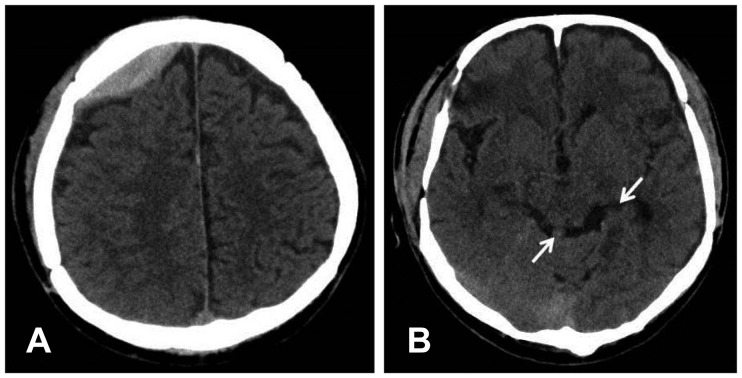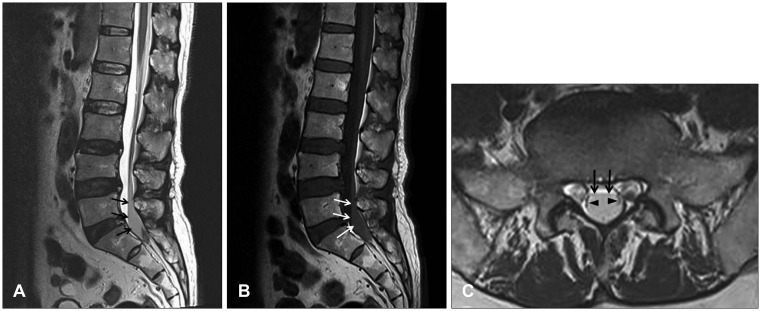Korean J Neurotrauma.
2016 Oct;12(2):159-162. 10.13004/kjnt.2016.12.2.159.
Spinal Subarachnoid Hemorrhage Migrated from Traumatic Intracranial Subarachnoid Hemorrhage
- Affiliations
-
- 1Department of Neurosurgery, Dongguk University Ilsan Hospital, Dongguk University College of Medicine, Goyang, Korea. ktcho21@naver.com
- KMID: 2356793
- DOI: http://doi.org/10.13004/kjnt.2016.12.2.159
Abstract
- Very rarely, spinal subarachnoid hemorrhage (SSAH) can occur without any direct spinal injury in patients with traumatic intracranial SAH. A-59-year-old male with traumatic intracranial subarachnoid hemorrhage (SAH) presented with pain and numbness in his buttock and thigh two days after trauma. Pain and numbness rapidly worsened and perianal numbness and voiding difficulty began on the next day. Magnetic resonance imaging showed intraspinal hemorrhage in the lumbosacral region. The cauda equina was displaced and compressed. Emergent laminectomy and drainage of hemorrhage were performed and SSAH was found intraoperatively. The symptoms were relieved immediately after the surgery. Patients with traumatic intracranial hemorrhage who present with delayed pain or neurological deficits should be evaluated for intraspinal hemorrhage promptly, even when the patients had no history of direct spinal injury and had no apparent symptoms related to the spinal injury in the initial period of trauma.
Keyword
MeSH Terms
Figure
Reference
-
1. Bortolotti C, Wang H, Fraser K, Lanzino G. Subacute spinal subdural hematoma after spontaneous resolution of cranial subdural hematoma: causal relationship or coincidence? Case report. J Neurosurg. 2004; 100:372–374. PMID: 15070147.2. Chen HC, Hsu PW, Tzaan WC. "Migration" of traumatic subarachnoid hematoma? A case report. Surg Neurol. 2008; 70:213–216. PMID: 17720228.
Article3. Di Rienzo A, Iacoangeli M, Alvaro L, Colasanti R, Moriconi E, Gladi M, et al. Subarachnoid hematoma of the craniocervical junction and upper cervical spine after traumatic cerebral contusion: case report. Neurol Med Chir (Tokyo). 2013; 53:620–624. PMID: 24067775.
Article4. Jung HS, Jeon I, Kim SW. Spontaneous spinal subdural hematoma with simultaneous cranial subarachnoid hemorrhage. J Korean Neurosurg Soc. 2015; 57:371–375. PMID: 26113966.
Article5. Kakitsubata Y, Theodorou SJ, Theodorou DJ, Miyata Y, Ito Y, Yuki Y, et al. Spontaneous spinal subarachnoid hemorrhage associated with subdural hematoma at different spinal levels. Emerg Radiol. 2010; 17:69–72. PMID: 19184145.
Article6. Kim HG, Kim TW, Park KH, Chi MP. Traumatic spinal subdural hematoma with intracranial subdural hematoma. Korean J Neurotrauma. 2014; 10:146–148. PMID: 27169053.
Article7. Mete A, Erkutlu I, Akcali A, Mete A. Simultaneous cranial subarachnoid hemorrhage and spinal subdural hematoma. Turk Neurosurg. 2012; 22:349–352. PMID: 22665005.
Article8. Moscovici S, Paldor I, Ramirez de-Noriega F, Itshayek E, Shoshan Y, Spektor S, et al. Do cranial subdural hematomas migrate to the lumbar spine? J Clin Neurosci. 2011; 18:563–565. PMID: 21257311.
Article
- Full Text Links
- Actions
-
Cited
- CITED
-
- Close
- Share
- Similar articles
-
- Spontaneous Spinal Subdural and Subarachnoid Hemorrhage with Concomitant Intracerebral Hemorrhage: A Case Report
- Subarachnoid Hemorrhage Presenting with Seizure due to Cerebrospinal Fluid Leakage after Spinal Surgery
- Spontaneous Spinal Subarachnoid Hemorrhage Report of a Case
- Study of Factors Associated with Neurological Outcome in Traumatic Subarachnoid Hemorrhage: Clinical Analysis
- Traumatic Intracranial Aneurysm Presenting with Delayed Subarachnoid Hemorrhage




